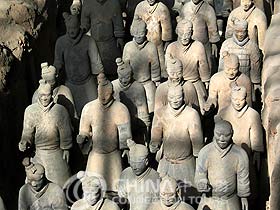
 Home of Qin Terra-cotta Warriors and Horses
Home of Qin Terra-cotta Warriors and Horses
An inland province along the middle reaches of the Yellow River and a gateway to northwest China, Shaanxi Province links the west with the east and connects the north with the south. The Eurasian continental bridge, an international economic link starting from Lianyungang in the east and ending in Rotterdam, Netherlands, passes through the province. It borders Ningxia, Inner Mongolia, Shanxi, Henan, Hubei, Sichuan and Gansu, covering an area of 205,600 sq km.
Shaanxi has a continental monsoonal climate, with a big difference between the areas north and south of the Qinling Mountain range. It has a mean annual temperature of 5.9ºC-15.7ºC, increasing from north to south, and a mean annual precipitation, less in the north than in the south: 340-600 mm. in northern Shaanxi, 570-700 mm. in the Guanzhong Plain and 800-1,210 mm. in southern Shaanxi.
The best time to visit Shaanxi is in the spring or autumn, since the summers are usually hot and rainy and the winters are cold.
Shaanxi, with Xi'an as its capital, is regarded as one of the cradles of Chinese civilization. Thirteen dynasties made this their national capital. Settlement in the province dates back to the Neolithic age, and some of China's oldest inhabitant remains have been found here along the life-sustaining Yellow River.
It was in the Shang Dynasty (1600-1100 BC), however, that settlement became more widespread, and written records have been recovered from that time. Beginning with the Zhou Dynasty (1100-221 BC), Xi'an has served as the capital for 13 dynasties spannning some 1,100 years.
The Han Dynasty (206 BC-220AD) made their capital near Xi'an, and brought a period of prosperity to the province that has rarely been seen since. The Silk Road, which came to prominence during that time, was to bring not only monetary wealth, but also a range of cultural treasures, from western travelers and religious pilgrims. Xi'an was to be, fairly consistently, China's main political center up until the end of the Tang Dynasty (618-907 AD).
At the end of the year 2005, the total population in Shaanxi Province stood at 37.20 million. Nearly all the people in Shaanxi are ethnic Han Chinese, with pockets of Hui people in the northwestern region adjacent to Ningxia. The southern part of Shaanxi, where Xi'an is located, is more populated than the northern part.
 Dispersed around Shaanxi Province are 72 imperial mausoleums, which testify to its ancient importance as the country's long time capital. The province is best known for five scenic spots: the Mausoleum of Huang Di, the Qin Terra-cotta Warriors and Horses, the Xi'an Forest of Stone Tablets, the Shaanxi History Museum, and the Xi'an City Wall. The Qin Terra-cotta Warriors and Horses are often called the eighth wonder of the world and has been included by UNESCO in its list of World Cultural Heritage sites. Tourists also can enjoy the famous dumpling banquet and Tang Dynasty dance and music show in Xi'an.
Dispersed around Shaanxi Province are 72 imperial mausoleums, which testify to its ancient importance as the country's long time capital. The province is best known for five scenic spots: the Mausoleum of Huang Di, the Qin Terra-cotta Warriors and Horses, the Xi'an Forest of Stone Tablets, the Shaanxi History Museum, and the Xi'an City Wall. The Qin Terra-cotta Warriors and Horses are often called the eighth wonder of the world and has been included by UNESCO in its list of World Cultural Heritage sites. Tourists also can enjoy the famous dumpling banquet and Tang Dynasty dance and music show in Xi'an.

